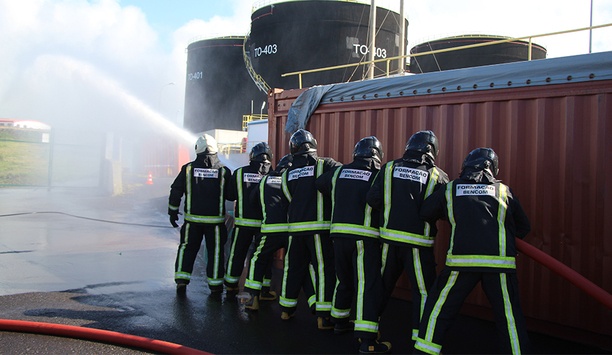The effective provision and management of on-site fire safety, prevention, response and protection is a core responsibility of operators of hazardous high-risk critical infrastructure and industrial manufacturing facilities around the world. Such services are typically found at airports, refineries and petrochemical plants, power stations and nuclear facilities, mines, manufacturing sites and port facilities.
Driven by legislative requirements and international fire safety standards, many organizations are required to maintain and operate an on-site Rescue and Fire Fighting Service (RFFS) or for airports, an Aircraft Rescue and Fire Fighting (ARFF) Service in order to meet their compliance requirements.
Legislative Compliance
Failure to fully comply can expose these organizations to the risk of serious financial liability in the event of an incident, Failure to fully comply can expose these organizations to the risk of serious financial liabilityas insurers demand that risk is minimised and mitigated before they will provide cover for the site and its operations.
Notwithstanding the availability of local or municipal resources to respond in the event of an emergency or serious incident, the RFFS and ARFF provision available to commercial organizations generally falls into two main options; an employed service or an outsourced service.
The Decision To outsource
While many organizations choose to invest in their own Fire and Rescue Service, which includes the provision of a Fire Station(s), personnel, vehicles and equipment, others have turned to outsourced service providers to enable them to meet their operational and compliance needs.
So what are the factors that influence a decision to outsource and how do organizations choose between the two options?
Managing risk and improving resilience
The requirement and resources for an on-site fire and rescue service will be determined chiefly by the type of activity that the organization is involved in at each site or facility, the assessment of the risks associated with the processes or activities that occur on-site and the impact that any emergency incident may have on the business, its employees and on the surrounding communities.
Ultimately, the motivation for investment in an on-site fire and rescue resource is rooted in the avoidance of loss, which can be both organizational, reputational and/or personal in nature and in a need to ensure the on-going stability, security and resilience of the facility and processes in question. But rather like when an insurance policy is purchased, one sincerely hopes that the Fire and Rescue Service will never need to be called upon to be utilized in a real-life emergency.
A decision to outsource may be driven by purely financial motives as organizations seek to reduce costs and enhance shareholder value or by strategic and tactical factors as the business seeks to re-engineer or re-focus itself.
 |
| Outsourcing enables companies to focus on their core business processes while delegating essential but non-core processes to external specialist providers |
Recruiting, training, resourcing, and supporting an employed on-site fire and rescue service is an expensive indirect operational cost for the business, consuming cash resources that could possibly be better invested elsewhere.
The day to day management of an employed Fire, Rescue and Safety service can also sap the organization of time and energy that, while imperative to the safe, legal and ultimately the profitable operation of the facility, is not actually a core function of the business itself.
Outsourcing enables companies to focus on their core business processes while delegating essential but non-core processes to external specialist providers. This releases internal resources that can be put to more effective use for other purposes, leading to greater efficiency and competitiveness.
Outsourcing enables companies to focus on their core business processes while delegating essential but non-core processes to external specialist providers
The question to be asked is, could an outsourced service provider deliver the required functions, tasks and compliance, maintain and improve site safety, respond effectively to any emergency incidents and add value to the organization at a more cost-effective rate than directly employing the on-site team?
When properly executed, outsourcing the on-site Fire and Rescue Service can have a defining impact on the company’s revenue recognition and can deliver significant savings through lower operational and labour costs.
Specialist knowledge, skills and expertise
Organizations cannot realistically be experts in every business function, process and discipline, it is simply far too expensive. By utilizing outsourced service providers, companies can leverage a global knowledge base and resource centre, accessing world class capabilities, skills and expertise that they may have been precluded from previously.
Managed FRS service providers often have access to a wider, more highly skilled and diverse talent pool than the client themselves and will already have in place the requisite interview and selection processes designed to select only the strongest, most appropriately qualified and experienced staff.
Shared experiences coupled with specialist skills, learning and best working practices also enable the outsourced service provider to add value and resilience to and further reduce risk within the client’s operation.
Shared responsibilities and liabilities
Although all organizations must maintain a duty of care to operate in a safe and environmentally responsible manner, delegating fire and rescue service responsibilities to external providers can release companies of the day to day functions that are difficult to manage and control, while still realizing their benefits and upholding compliance.
Outsourced FRS service providers generally are much better at deciding how to avoid risk in their areas of expertise
As specialists in their field, outsourced FRS service providers generally are much better at deciding how to avoid risk in their areas of expertise than perhaps a fully employed on-site team might be. This is because the incentive to deliver a high level of service and to maintain their professional reputation while remaining profitable is potentially stronger for the outsourced provider.
A further consideration if, unfortunately something does go wrong, may be that the responsibility and possible consequential contractual liability might well rest in whole or in part with the service provider, rather than the contracting client themselves.
what are the potential negatives?
Violations of confidentiality and intellectual property are of increasing concern to companies. This is particularly true for clients that outsource to providers from countries that may not have the same type or standards of confidentiality laws that prevail in their home jurisdiction.
One way to mitigate this issue is to have strong confidentiality clauses contained within all commercial contractual documentation and employee contracts, and to make security of data and information a key performance indicator within any outsource contract.
Outsourcing may in some cases result in job eliminations or employees leaving for other personal reasons, which in turn can have a negative effect on morale, loyalty and productivity among the personnel who remain.
Human Resources In FRS
In most cases for Fire and Rescue Service outsourcing, human resource levels are already stipulated based on the site or facility risk profile and therefore it is more likely that existing employees will simply be transferred to a new contract of employment with the new service provider, albeit perhaps on slightly different terms.
There are also often hidden costs that, if not managed correctly, can quickly negate many of the anticipated savings
Although most companies see an immediate benefit to the bottom line when outsourcing, there are also often hidden costs that, if not managed correctly, can quickly negate many of the anticipated savings.
It should not be underestimated that, as in any period of change, increased ancillary costs such as travel and related expenses can accrue as employees travel back and forth for training and other meetings, particularly during the mobilization phase of the new contract.
Making your mind up
The decision to outsource the Fire and Rescue Service for a high-risk site or facility should never be made lightly. A thorough and detailed examination of the associated costs and benefits must be investigated before a go/no go decision is reached.
However, if a decision to outsource is positive, then careful selection of your partner organization, taking account of both the hard and soft delivery factors for each facility, is of critical importance.


















